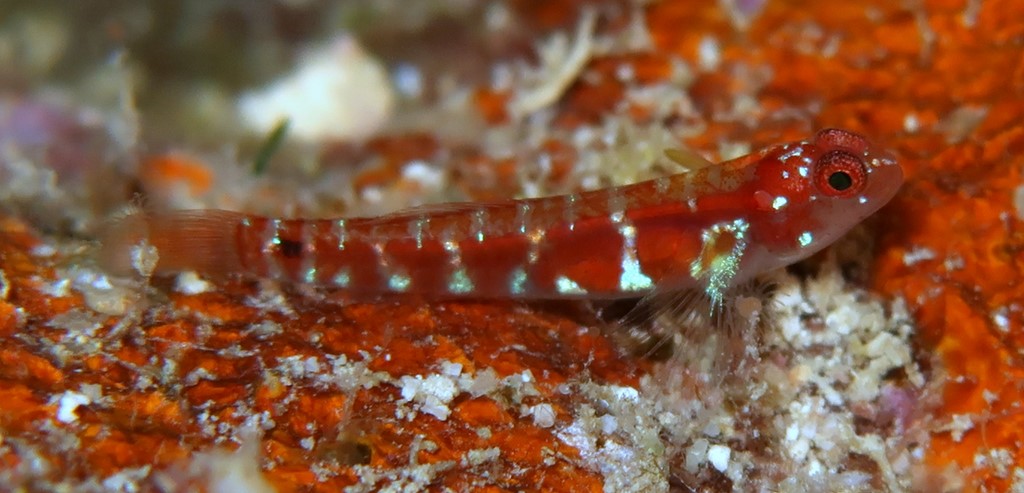EVIOTA LATIFASCIATA - (JEWETT & LACHNER, 1983)
Picture courtesy of: Alain Daoulas
Actinopterygii (Gigaclass) > Actinopteri (Class) > Teleostei (Subclass) > Gobiiformes (Order) > Gobioidei (Suborder) > Gobiidae (Family) > Gobiinae (Subfamily) > Eviota (Genus)
Brownbanded dwarfgoby, Brown-banded dwarfgoby, Broadbarred pygmygoby, Broad-Bbanded pygmy goby, Obiisohaze, オビイソハゼ, 侧带矶塘鳢,
Synonyme
Eviota latifasciatus (Jewett & Lachner, 1983)
---------------------------
Description
Dorsal spines (total): 7; Dorsal soft rays (total): 7-9; Anal spine: 1; Anal soft rays: 8-9; Longitudinal scale series 23-25. Body depth: 4.5-5.0 in SL; Scales ctenoid, absent from head, nape, chest and pectoral-fin base; Pelvic fins separate, with a thin membrane joining bases; Fourth pelvic-fin ray with 7-11 branches. Max. length: 1.5 cm SL, usually: 2.0 cm TL. Depth range: 4 - 25 m.
Color
Semi-transparent body with 6-7 large brown blotches or broad bars along the side, sometimes with narrow white bars, and white markings on top of the head, and a dark caudal-peduncle spot over preural centrum centered on lateral midline.
Etymology
Eviota: from Greek prefix, ev-, eu-, = good or well, very + from Greek letter, iota = smallest letter in the Greek alphabet and often figuratively used to describe anything small or insignificant. Referring to Eviota epiphanes (Jenkins, 1903), which, at 1.0-1.9 cm in length, Jenkins claimed was the “smallest vertebrate that has up to this time been described”.
latifasciata: from Latin, latus = wide + from Latin, fasciatus = banded. Referring to broad subcutaneous bars on trunk.
Original description: Eviota latifasciata Jewett & Lachner, 1983 - Type locality: off Bolton Point, Abaiang Atoll, Gilbert Islands, southern Pacific, depth 7.6-10.7 meters.
Distribution
Eastern Indian Ocean and West Pacific: Christmas Island, Indonesia (Sulawesi, Lesser Sundas, Banda, West Papua), north to Japan (Okinawa and Ryukyu Islands) and Micronesia (Palau, FSM [Pohnpei], and Kiribati), east to New Caledonia, Solomon Islands, Fiji, Tonga and French Polynesia (Austral Islands).
Biology
Solitary, rests on bottom. Inhabits exposed coastal reefs and outer slopes.
Similar species
Eviota dorsimaculata (Tornabene, Ahmadia & Williams, 2013) - Reported from Marquesas Islands.
Eviota santanai (Greenfield & Erdmann, 2013) - Reported from Timor-Leste, Timor.
Last update: 8, August 2022
Actinopterygii (Gigaclass) > Actinopteri (Class) > Teleostei (Subclass) > Gobiiformes (Order) > Gobioidei (Suborder) > Gobiidae (Family) > Gobiinae (Subfamily) > Eviota (Genus)
Brownbanded dwarfgoby, Brown-banded dwarfgoby, Broadbarred pygmygoby, Broad-Bbanded pygmy goby, Obiisohaze, オビイソハゼ, 侧带矶塘鳢,
Synonyme
Eviota latifasciatus (Jewett & Lachner, 1983)
---------------------------
Description
Dorsal spines (total): 7; Dorsal soft rays (total): 7-9; Anal spine: 1; Anal soft rays: 8-9; Longitudinal scale series 23-25. Body depth: 4.5-5.0 in SL; Scales ctenoid, absent from head, nape, chest and pectoral-fin base; Pelvic fins separate, with a thin membrane joining bases; Fourth pelvic-fin ray with 7-11 branches. Max. length: 1.5 cm SL, usually: 2.0 cm TL. Depth range: 4 - 25 m.
Color
Semi-transparent body with 6-7 large brown blotches or broad bars along the side, sometimes with narrow white bars, and white markings on top of the head, and a dark caudal-peduncle spot over preural centrum centered on lateral midline.
Etymology
Eviota: from Greek prefix, ev-, eu-, = good or well, very + from Greek letter, iota = smallest letter in the Greek alphabet and often figuratively used to describe anything small or insignificant. Referring to Eviota epiphanes (Jenkins, 1903), which, at 1.0-1.9 cm in length, Jenkins claimed was the “smallest vertebrate that has up to this time been described”.
latifasciata: from Latin, latus = wide + from Latin, fasciatus = banded. Referring to broad subcutaneous bars on trunk.
Original description: Eviota latifasciata Jewett & Lachner, 1983 - Type locality: off Bolton Point, Abaiang Atoll, Gilbert Islands, southern Pacific, depth 7.6-10.7 meters.
Distribution
Eastern Indian Ocean and West Pacific: Christmas Island, Indonesia (Sulawesi, Lesser Sundas, Banda, West Papua), north to Japan (Okinawa and Ryukyu Islands) and Micronesia (Palau, FSM [Pohnpei], and Kiribati), east to New Caledonia, Solomon Islands, Fiji, Tonga and French Polynesia (Austral Islands).
Biology
Solitary, rests on bottom. Inhabits exposed coastal reefs and outer slopes.
Similar species
Eviota dorsimaculata (Tornabene, Ahmadia & Williams, 2013) - Reported from Marquesas Islands.
Eviota santanai (Greenfield & Erdmann, 2013) - Reported from Timor-Leste, Timor.
Last update: 8, August 2022
